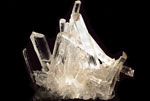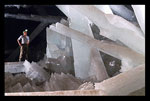Gypsum - Mineral and Healing Properties


Chemistry: CaSO4-2(H2O), Hydrated Calcium Sulfate
Class: Sulfates
Subclass:
Uses: Plaster, wall board, some cements, fertilizer, paint filler, ornamental stone
CLICK HERE To Purchase Kidz Rocks Gypsum Products.
-
 Gypsum
Gypsum -
 Gypsum Crystal
Gypsum Crystal -
 Naica Mine Mexico
Naica Mine Mexico
Gypsum is one of the more common minerals in sedimentary environments. It is a major rock forming mineral that produces massive beds, usually from precipitation out of highly saline waters. Since it forms easily from saline water, gypsum can have many inclusions of other minerals and even trapped bubbles of air and water.
Gypsum has several variety names that are widely used in the mineral trade. "Selenite" is the colorless and transparent variety that shows a pearl like luster and has been described as having a moon like glow. The word selenite comes from the Greek for Moon and means moon rock. Another variety is a compact fiberous aggregate called "satin spar" . This variety has a very satin like look that gives a play of light up and down the fiberous crystals. A fine grained massive material is called "alabaster" and is an ornamental stone used in fine carvings for centuries, even eons.
Crystals of gypsum can be extremely colorless and transparent, making a strong contrast to the most common usage in drywall. The crystals can also be quite large. Gypsum is a natural insulator, feeling warm to the touch when compared to a more ordinary rock or quartz crystal. Sheets of clear crystals can be easily peeled from a larger specimen.

Origin Of The Name
The name Gypsum comes from the Greek words"gypsos" which means "plaster". Gypsum comes from the Greek, gyps meaning "burned" mineral.

Interesting Facts
The largest deposit of gypsum in the world is White Sands National Monument in New Mexico. There over 275 square miles of shifting gypsum sand dunes cover the area. Gypsum was used by Native Americans as long ago as 3000 years for the white pigments, which they used for decorating pottery, teepees, body paint, and shields. Egyptians used gypsum as jointing material in the monuments they built over 5000 years ago.
Gypsum crystals can be extremely large - among the largest on the entire planet. A cave in Naica, Mexico contains crystals as large as 4 feet in diameter and 50 feet long. Apparently, ideal conditions for the slow growth of gypsum were maintained for thousands of years, allowing crystals to grow to enormous sizes.
In the early nineteenth century it was regarded as an almost miraculous fertilizer. American farmers were so anxious to acquire it that a lively smuggling trade with Nova Scotia evolved, resulting in the so-called "Plaster War" of 1812.
Orbital pictures from the Mars Reconnaissance Orbiter (MRO) indicate the existence of gypsum dunes in the northern polar region of Mars.
The transparent form of gypsum (selenite) was used for windows before glass was created.

Where Is It Found
Gypsum is a common mineral, with thick and extensive evaporite beds in association with sedimentary rocks. Deposits are known to occur in strata from as far back as the Archaean eon. Gypsum is deposited from lake and sea water, as well as in hot springs, from volcanic vapors, and sulfate solutions in veins. Hydrothermal anhydrite in veins is commonly hydrated to gypsum by groundwater in near surface exposures.
Commercial quantities of gypsum are found in the cities of Araripina and Graja£, Brazil, Pakistan, Jamaica, Iran (world's second largest producer), Thailand, Spain (the main producer in Europe), Germany, Italy, England, Ireland, in British Columbia, Manitoba, Ontario, Nova Scotia and Newfoundland in Canada, and in New York, Michigan, Indiana, Texas (in the Palo Duro Canyon), Iowa, Kansas, Oklahoma, Arizona, New Mexico, Colorado, Utah, Arkansas and Nevada in the United States. There is also a large open pit quarry located at Plaster City, California, in Imperial County, and in East Kutai, Kalimantan. Several small mines also exist in places like Kalannie in Western Australia where gypsum is sold to private buyers for changing the pH levels of soil for agricultural purposes.

What Do We Do With It
Gypsum is one of the most widely used minerals in the world. Most is used to make wall board, also know as sheet rock. It is estimated that the average American home contains seven metric tons of gypsum. Gypsum is also added to concrete to strengthen the material, so it can be used in concrete for roads, bridges and sidewalks just to name a few. Gypsum can also be used as a fertilizer by adding it directly to the soil. This increases the productivity of the land. It can be added to paint as a filler. Used in these ways, gypsum must first be ground up into a powder and dried.
It is thought that the first uses of gypsum were for sculptures. Alabaster is a soft solid form of gypsum that takes carvings well thus it was able to be carved into many different shaped objects. 5,000 years ago the Egyptians learned to turn the gypsum into what we now call Plaster of Paris, and they used it to line the walls of their living quarters. They discovered that if the gypsum was ground up into a fine powder and dried, that they could later add water, mix and use as cement. Gypsum contains a large amount of water, and this gives it fire protection qualities. This is important because it will give some protection from house fires. It is also important because it can be used as molds, allowing melted metals to be poured and formed within. Tiles found in the bathroom are more often than not attached to the wall with a form of gypsum mortar. Plates, cups and saucers from our kitchen were most likely poured into a gypsum formed mold. The uses of gypsum are, as we can see nearly endless.

Metaphysical Uses
A protective stone, Selenite shields a person or space from outside influences. Selenite can evoke protection from the angelic realm and also dispels negative energy. The powerful energies of Selenite help one connect with one's guides, guardians, Christ Consciousness and Higher Self. Selenite can be held or placed around a person to facilitate such a connection.
Selenite calms and soothes, bringing a deep peace and sense of tranquility. Use Selenite in a grid around your home or in the corners of a room to create a safe and peaceful space. Meditating with Selenite aids in access to past and future lives. Selenite brings mental clarity, clearing confusion and revealing the bigger picture behind any problem. Selenite is a crystallized form of Gypsum, which is used for good luck and protection. The powerful vibration of Selenite can clear, open, and activate the Crown and Higher Chakras and is excellent for all types of spiritual work. Selenite can also be used to strengthen the memory.
Physically, Selenite removes energy blockages from physical and Etheric bodies. It can reverse the effects of free radicals to heal and repair on the cellular level. Selenite is associated with the spine and the skeletal system. Selenite can be used to mitigate problems with Mercury fillings in dental work. Selenite is also good for breast feeding.

Physical Characteristics
Color: White, colorless or gray, but can also be shades of red, brown and yellow
Luster: Vitreous to pearly especially on cleavage surfaces
Transparency: Crystals are transparent to translucent
Crystal System: Monoclinic; 2/m
Crystal Habits: Tabular, bladed or blocky crystals with a slanted parallelogram outline. The pinacoid faces dominate with jutting prism faces on the edges of the tabular crystals. Long thin crystals show bends and some specimens bend into spirals called "Ram's Horn Selenite" Two types of twinning are common and one produces a "spear head twin" or "swallowtail twin" while the other type produces a "fishtail twin". Also massive, crusty, granular, earthy and fiberous.
Cleavage: Good in one direction and distinct in two others
Fracture: Uneven but rarely seen
Hardness: 2
Specific Gravity: 2.3
Streak: White
Associated Minerals: halite, calcite, sulfur, pyrite, borax and many others.
Best Field Indicators: Crystal habit, flexible crystals, cleavage and hardness

Educational Videos
How Gypsum Becomes Wallboard




